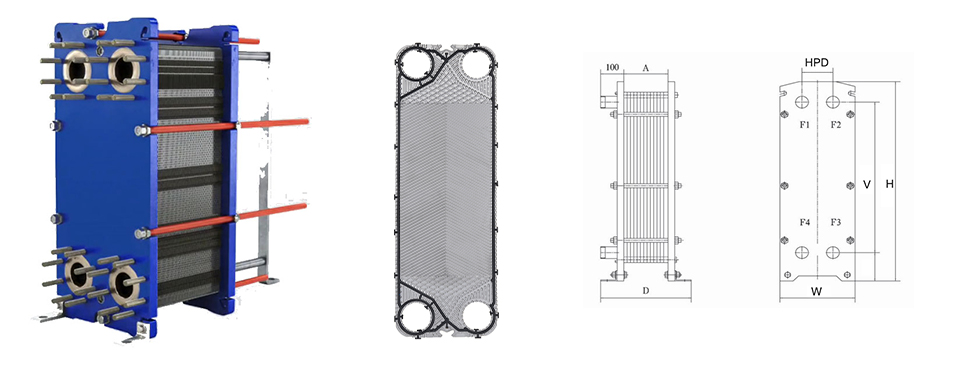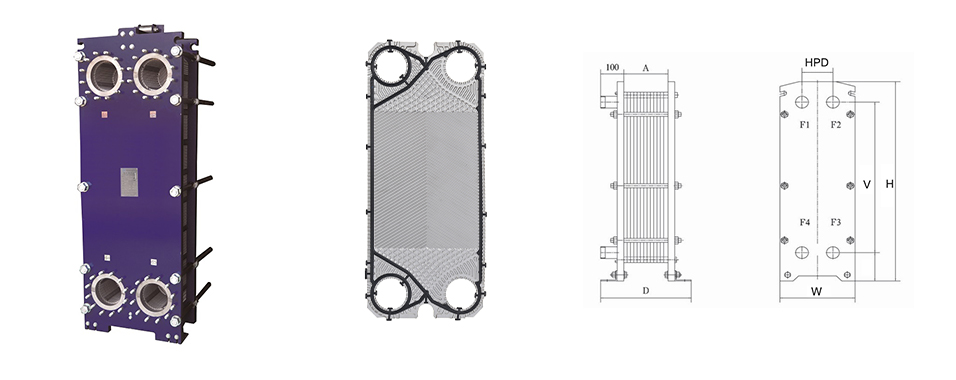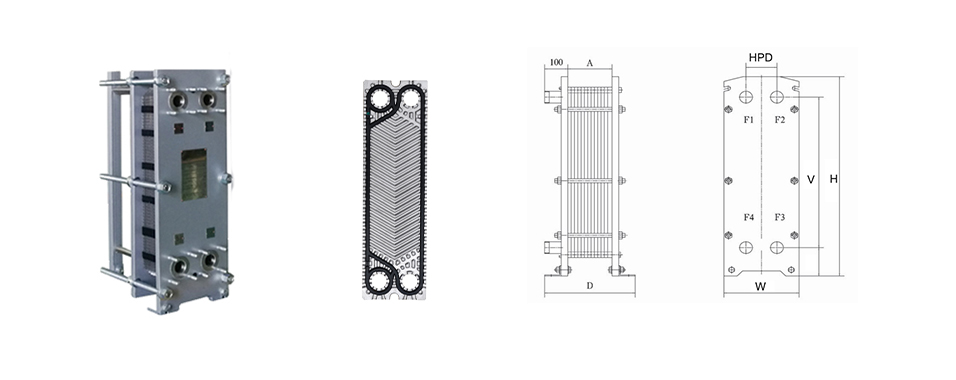Many plate heat exchangers are made of corrugated plates on a frame. This creates high turbulence and high wall shear stress, resulting in a high heat transfer and a high fouling resistance.
Get In Touch
Recommend Read
-

Method for cleaning vicarb heat exchanger plate
Vicarb heat exchanger plates have been widely used in some areas such as central heating and chemical industry. The plate heat exchanger has a good heat exchange effect, but it is prone to produce scale and impurities, which will block the flow of the plate heat exchanger and reduce the heat exchange effect. So, how to clean the plate heat exchanger?Plate heat exchangers can be disassembled and recirculated.
Disassembly and cleaning steps:
Disassembly and cleaning can clean both processes of the heat exchanger. The main steps are:
1. Close the two water inlet and outlet valves of the heat exchanger;
2. Measure the distance between the baffles of the heat exchanger and make a record;
3. Disassemble the plate heat exchanger, empty the medium in the equipment, disassemble in the prescribed order, and make a record. Be careful not to damage the gasket and the plate during the disassembly process;
4. During the cleaning process, the plates should be cleaned piece by piece, and soaked and washed. In the case of high-pressure cleaning, the cleaning should be performed below the specified pressure;
5. After processing, put it back in the plate heat exchanger baffle in the original order, paying attention to distinguish the front and back. Control the strength when tightening the clamping bolts firmly, otherwise it is easy to crush the plate;
6. Open the outlet valve and inlet valve of the plate heat exchanger to see if there is any leakage. If there is no leakage, the cleaning is complete.
Cycle cleaning steps:
If it is used in the chemical industry, firstly close the inlet and outlet valves of the plate heat exchanger, and add the cleaning agent to the system through a tube pump or a water tank for internal circulation until the concentration of the cleaning agent no longer changes and the impurities in the equipment are discharged.
If it is a passivation treatment, it is necessary to ensure that after the chemical descaling is completed, no rust or other phenomena will occur in the pipeline. The amount of passivation cleaning solution needs to be determined according to the amount of water during cleaning, and the ph value cannot be too high, otherwise the effect will be poor, and it will be discharged after six hours.
Finally, the plate heat exchanger was restored, and the inlet and outlet water valves were opened, indicating that the cleaning was completed. -

The role and advantages,disadvantages of plate heat exchangers
Plate heat exchangers are a type of mobile device that transfers heat between metal plates because the liquid is spread over more surfaces, which increases the exchange rate. Metal tubes are used to heat fluids.
The role of plate heat exchangers
The plate heat exchanger is based on different external and internal components, the welding plate exchange plates are welded together, and the brazed plate type construction model is vacuum brazed. In many cases, in order to make smaller sections work better, some chambers are designed to be thinner, allowing most of the liquid to contact the plate, improving heat transfer.
The plate heat exchanger can play a good heat transfer effect in the boiler heating in winter. In the daily use process, it is necessary to do a good job of protecting this equipment. The plate heat exchanger is a kind of equipment that can play multiple benefits and functions for us. The user clearly knows its role and protects it so that it can play a greater role.
Advantages of plate heat exchangers
High heat transfer coefficient. The plate heat exchanger has a small flow channel, the plates are wavy, and the cross-section changes are complex, which makes the flow direction and velocity of the fluid constantly change, which increases the disturbance of the fluid and has a high heat transfer coefficient.
Great adaptability. The required heat transfer area can be achieved by increasing or decreasing the plate. A heat exchanger can be divided into several units, which can be used for heating or cooling between several fluids at the same time.
Compact structure, small size and few consumables. The heat transfer area per cubic meter volume can reach 250m2, and the heat transfer surface per square meter only needs about 15kg of metal.
Dirt factor is small. Due to the large flow disturbance, dirt is not easily deposited. The plate heat exchanger plate is of good material and has little corrosion, which makes its fouling coefficient value smaller. Plate heat exchangers mainly use metal plates, so the price of raw materials is cheaper than the same metal pipes.
Disadvantages of plate heat exchangers
1) Poor sealing and easy to leak. The gasket needs to be replaced frequently, which is troublesome.
2) The use pressure is limited, and generally does not exceed 1MPa.
3) The use temperature is limited by the temperature resistance of the gasket material. -

Gasketed Plate Heat Exchanger VHX151
VHX supply gasketed plate heat exchangers from 0.03m2 to 1.8m2 for different application requirements. We manufacture plate heat exhcanger for replacement models and our own brand models, available calibre from DN25 to DN350.

Available plate material: AISI304/AISI316/Titanium/Nickel/Alloy C-276/254 SMOModel Height Width Min Standard Length Max Standard Length Vertical Port Distance Horizontal Port Distance Connection VHX25 480 180 20 350 357 60 DN25 VHX51 940 330 35 600 640 140 DN50 VHX52 920 320 25 450 640 140 DN50 VHX61 835 325 50 630 625 130 DN65 VHX62 1085 325 50 630 875 130 DN65 VHX101 1084 470 120 950 719 225 DN100 VHX102 1084 470 80 640 719 225 DN100 VHX103 1235 500 115 1125 882 234 DN100 VHX104 1655 500 115 1125 1302 234 DN100 VHX151 1885 650 235 1410 1294 298 DN150 VHX152 1885 610 160 1255 1294 298 DN150 VHX201 2055 730 235 1645 1478 342 DN200 VHX301 2086 1125 215 2580 1320 600 DN300 VHX351 2920 1190 210 3360 1842 596 DN350
Available gasket material: NBR/EPDM/HNBR/NBR-HT/EPDM-HT/Viton-A/FKM/Viton-G/FKM/CR
Available connection material: rubber/stainless steel/unlined/flange
-

Plate heat exchanger VHX102
VHX supply plate heat exchangers from 0.03m2 to 1.8m2 for different application requirements. We manufacture plate heat exhcanger for replacement models and our own brand models, available calibre from DN25 to DN350.

Available plate material: AISI304/AISI316/Titanium/Nickel/Alloy C-276/254 SMOModel Height Width Min Standard Length Max Standard Length Vertical Port Distance Horizontal Port Distance Connection VHX25 480 180 20 350 357 60 DN25 VHX51 940 330 35 600 640 140 DN50 VHX52 920 320 25 450 640 140 DN50 VHX61 835 325 50 630 625 130 DN65 VHX62 1085 325 50 630 875 130 DN65 VHX101 1084 470 120 950 719 225 DN100 VHX102 1084 470 80 640 719 225 DN100 VHX103 1235 500 115 1125 882 234 DN100 VHX104 1655 500 115 1125 1302 234 DN100 VHX151 1885 650 235 1410 1294 298 DN150 VHX152 1885 610 160 1255 1294 298 DN150 VHX201 2055 730 235 1645 1478 342 DN200 VHX301 2086 1125 215 2580 1320 600 DN300 VHX351 2920 1190 210 3360 1842 596 DN350
Available gasket material: NBR/EPDM/HNBR/NBR-HT/EPDM-HT/Viton-A/FKM/Viton-G/FKM/CR
Available connection material: rubber/stainless steel/unlined/flange
Thermowave Plate Heat Exchanger Gasket -

Heat Exchanger Plate VHX25
VHX supply heat exchanger plates from 0.03m2 to 1.8m2 for different application requirements. We manufacture plate heat exhcanger for replacement models and our own brand models, available calibre from DN25 to DN350.

Available plate material: AISI304/AISI316/Titanium/Nickel/Alloy C-276/254 SMOModel Height Width Min Standard Length Max Standard Length Vertical Port Distance Horizontal Port Distance Connection VHX25 480 180 20 350 357 60 DN25 VHX51 940 330 35 600 640 140 DN50 VHX52 920 320 25 450 640 140 DN50 VHX61 835 325 50 630 625 130 DN65 VHX62 1085 325 50 630 875 130 DN65 VHX101 1084 470 120 950 719 225 DN100 VHX102 1084 470 80 640 719 225 DN100 VHX103 1235 500 115 1125 882 234 DN100 VHX104 1655 500 115 1125 1302 234 DN100 VHX151 1885 650 235 1410 1294 298 DN150 VHX152 1885 610 160 1255 1294 298 DN150 VHX201 2055 730 235 1645 1478 342 DN200 VHX301 2086 1125 215 2580 1320 600 DN300 VHX351 2920 1190 210 3360 1842 596 DN350
Available gasket material: NBR/EPDM/HNBR/NBR-HT/EPDM-HT/Viton-A/FKM/Viton-G/FKM/CR
Available connection material: rubber/stainless steel/unlined/flange





